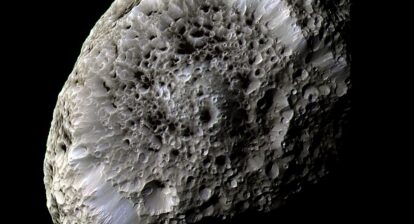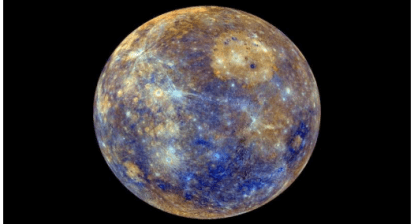
Composite image showing the DART impactor and Dimorphos. Credit: NASA
On September 26, 2022 NASA deliberately crashed a spacecraft with a small asteroid.
The video shows the “final five-and-a-half minutes of images leading up to the DART spacecraft’s intentional collision with asteroid Dimorphos. The DART spacecraft streamed these images from its DRACO camera back to Earth in real time as it approached the asteroid. This replay movie is 10 times faster than reality, except for the last six images, which are shown at the same rate that the spacecraft returned them. Both Didymos and its moonlet Dimorphos are visible at the start of the movie. At the end, Dimorphos fills the field of view. The final image in the movie shows a patch of Dimorphos that is 51 feet 16 meters) across. DART’s impact occurred during transmission of the final image to Earth, resulting in a partial picture at the end of this movie. Didymos is roughly 2,500 feet (780 meters) in diameter; Dimorphos is about 525 feet (160 meters) in length”.

15 days before impact, the DART spacecraft deployed a small companion satellite to document its historic planetary defense technology demonstration. Provided by the Italian Space Agency, the Light Italian CubeSat for Imaging Asteroids, aka LICIACube, recorded this image of the event’s aftermath. A cloud of ejecta is seen near the right edge of the frame captured only minutes following DART’s impact with target asteroid Dimorphos while LICIACube was about 80 kilometers away. Presently about 11 million kilometers from Earth, 160 meter diameter Dimorphos is a moonlet orbiting 780 meter diameter asteroid Didymos. Didymos is seen off center in the LICIACube image. Credit: ASI/NASA
According to NASA, “DART is the first-ever mission dedicated to investigating and demonstrating one method of asteroid deflection by changing an asteroid’s motion in space through kinetic impact. This method will have DART deliberately collide with a target asteroid—which poses no threat to Earth— in order to change its speed and path. DART’s target is the binary, near-Earth asteroid system Didymos, composed of the roughly 780-meter (2,560-foot) -diameter “Didymos” and the smaller, approximately 160-meter (530-foot)-size “Dimorphos,” which orbits Didymos. DART will impact Dimorphos to change its orbit within the binary system, and the DART Investigation Team will compare the results of DART’s kinetic impact with Dimorphos to highly detailed computer simulations of kinetic impacts on asteroids. Doing so will evaluate the effectiveness of this mitigation approach and assess how best to apply it to future planetary defense scenarios, as well as how accurate the computer simulations are and how well they reflect the behavior of a real asteroid. DART is a spacecraft designed to impact an asteroid as a test of technology. DART’s target asteroid is NOT a threat to Earth. This asteroid system is a perfect testing ground to see if intentionally crashing a spacecraft into an asteroid is an effective way to change its course, should an Earth-threatening asteroid be discovered in the future. Below is an animation of the spacecraft and the asteroids.
And it turns out the mission was a success! Below is the excerpt from NASA’s press release on October 11, 2022.
Analysis of data obtained over the past two weeks by NASA’s Double Asteroid Redirection Test (DART) investigation team shows the spacecraft’s kinetic impact with its target asteroid, Dimorphos, successfully altered the asteroid’s orbit. This marks humanity’s first time purposely changing the motion of a celestial object and the first full-scale demonstration of asteroid deflection technology.
“All of us have a responsibility to protect our home planet. After all, it’s the only one we have,” said NASA Administrator Bill Nelson. “This mission shows that NASA is trying to be ready for whatever the universe throws at us. NASA has proven we are serious as a defender of the planet. This is a watershed moment for planetary defense and all of humanity, demonstrating commitment from NASA’s exceptional team and partners from around the world.”
Prior to DART’s impact, it took Dimorphos 11 hours and 55 minutes to orbit its larger parent asteroid, Didymos. Since DART’s intentional collision with Dimorphos on Sept. 26, astronomers have been using telescopes on Earth to measure how much that time has changed. Now, the investigation team has confirmed the spacecraft’s impact altered Dimorphos’ orbit around Didymos by 32 minutes, shortening the 11 hour and 55-minute orbit to 11 hours and 23 minutes. This measurement has a margin of uncertainty of approximately plus or minus 2 minutes.
Before its encounter, NASA had defined a minimum successful orbit period change of Dimorphos as change of 73 seconds or more. This early data show DART surpassed this minimum benchmark by more than 25 times.
“This result is one important step toward understanding the full effect of DART’s impact with its target asteroid” said Lori Glaze, director of NASA’s Planetary Science Division at NASA Headquarters in Washington. “As new data come in each day, astronomers will be able to better assess whether, and how, a mission like DART could be used in the future to help protect Earth from a collision with an asteroid if we ever discover one headed our way.”

This imagery from NASA’s Hubble Space Telescope from Oct. 8, 2022, shows the debris blasted from the surface of Dimorphos 285 hours after the asteroid was intentionally impacted by NASA’s DART spacecraft on Sept. 26. The shape of that tail has changed over time. Scientists are continuing to study this material and how it moves in space, in order to better understand the asteroid.
Credits: NASA/ESA/STScI/Hubble
The spacecraft launched on a SpaceX Falcon 9 rocket out of Vandenberg Space Force Base in California.
LAUNCH:
November 23, 2021, 10:21 p.m. PST
(November 24, 2021, 1:21 a.m. EST)
DART IMPACT:
September 26, 2022, 7:14 p.m. EDT
Watch the video below for details.
Credit: NASA/Johns Hopkins APL and NASA DART Mission





![The Great Dark Spot (top), Scooter (middle white cloud),[97] and the Small Dark Spot (bottom), with contrast exaggerated.](https://www.360onhistory.com/wp-content/uploads/2024/01/Neptune_storms-414x224.jpg)

